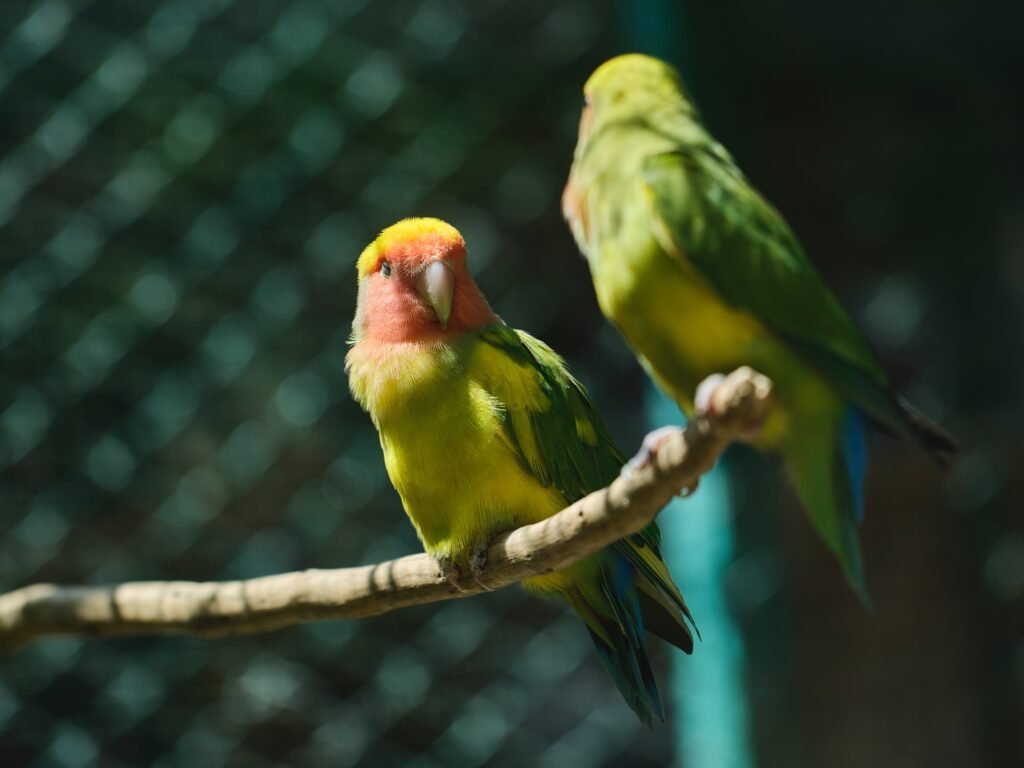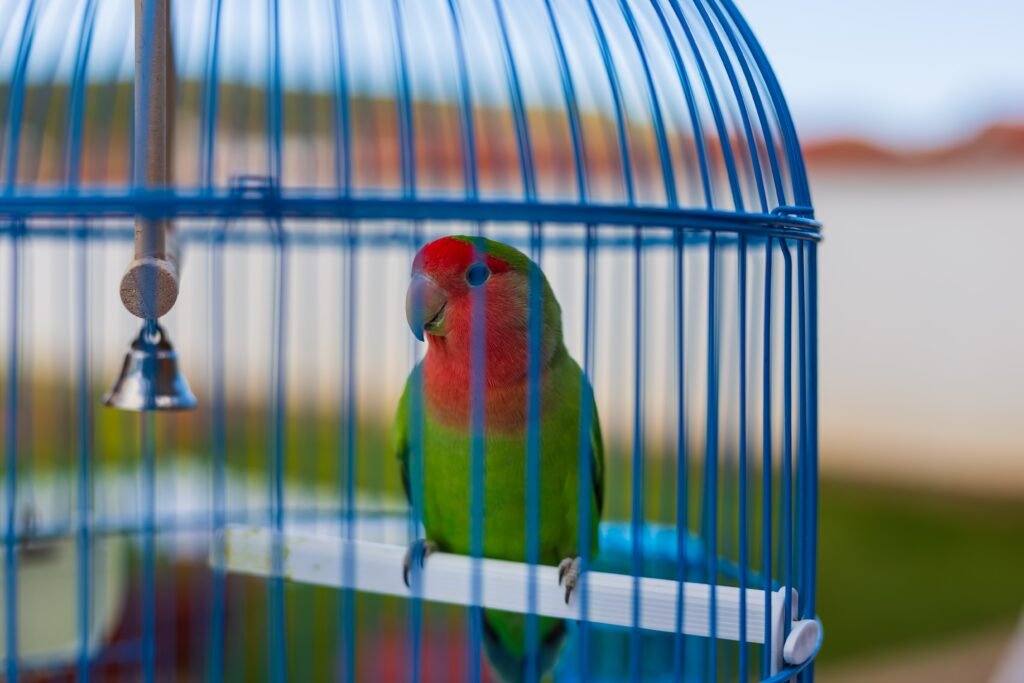Lovebirds, with their vibrant colors and affectionate behavior, are fascinating creatures that captivate bird enthusiasts worldwide. These small parrots are renowned for their unique communication skills and the strong bonds they form with their mates. This article will delve into the intriguing world of lovebird communication, exploring how they connect and convey messages through their behavior.
Vocal Communication
Lovebirds are highly vocal birds and use a variety of sounds to communicate with their companions. Their vocal repertoire includes chirping, hooting, whistling, and even mimicking human speech in some cases. Lovebirds are believed to use different vocalizations to express their emotions and convey specific messages.
Courtship Calls
During courtship, male lovebirds often emit loud, repetitive calls to attract the attention of their potential mates. High-pitched tones characterize these calls and serve as a way for males to display their availability and interest in breeding. The female lovebirds respond to these courtship calls with softer vocalizations, indicating their receptiveness to the male’s advances.
In addition to expressing their interest in breeding, courtship calls also serve as a way for lovebirds to establish a connection and strengthen their bond. The repetitive nature of these calls creates a rhythmic pattern that can be heard from a distance, allowing lovebirds to locate each other even in dense foliage. This vocal communication during courtship is a crucial component of their mating rituals and contributes to the overall success of their breeding efforts.
Contact Calls
Lovebirds also use contact calls to communicate with each other and maintain social bonds. These calls are typically short and high-pitched, serving as a way for lovebirds to locate each other and ensure they are nearby. Contact calls are particularly important when lovebirds are separated or want to establish their presence within their shared territory.
Contact calls can vary in intensity and frequency, depending on the situation. When lovebirds are within proximity, contact calls may be softer and more frequent, serving as a reassurance that their mate or flock member is nearby. On the other hand, when lovebirds are separated, contact calls may become louder and more persistent, acting as a means of seeking reunification. These calls serve as a way for lovebirds to locate each other and help maintain a sense of security and togetherness within the flock.
Warning Calls
In the wild, lovebirds rely on warning calls to alert their flock members about potential dangers. These calls are loud and distinct, signaling other lovebirds to stay vigilant and take necessary precautions. Warning calls can vary depending on the type of threat, allowing lovebirds to communicate specific information about the nature and location of the perceived danger.
Lovebirds have developed a sophisticated warning call system that enables them to communicate effectively within their flock. For example, a warning call indicating the presence of a predator may be sharp and rapid. In contrast, a warning call for a potential territorial dispute may be more prolonged and intense. Using different types of warning calls, lovebirds can convey detailed information to their flock members, allowing them to respond appropriately and protect themselves from potential harm.
Body Language
Apart from vocal communication, lovebirds also utilize body language to convey their feelings and intentions. Observing their body postures and movements can provide valuable insights into their emotions and social dynamics. Here are some key aspects of lovebirds’ body language:
Head Bobbing
Lovebirds often engage in head bobbing, which is a common behavior observed during courtship and social interactions. This rhythmic movement signifies excitement, happiness, or a desire to communicate with their mate or fellow flock members. Head bobbing can also indicate curiosity or attentiveness to their surroundings.
During courtship, head bobbing is particularly prominent for lovebirds to express their interest and attraction to their potential mates. The rhythmic nature of head bobbing creates a visual display that captures the attention of their intended partner, signaling their desire for companionship. In social interactions, head bobbing can also serve as a greeting or acknowledgment, reinforcing the social bonds within the flock.
Wing Flapping
Wing flapping is another form of body language frequently displayed by lovebirds. This behavior is often associated with feelings of joy, celebration, and playfulness. Lovebirds may flap their wings when excited, content, or simply expressing happiness. It is a visual display of their energy and enthusiasm.
Wing flapping is not only a form of self-expression but can also serve as a means of communication between lovebirds. For example, during courtship, wing flapping can be a way for male lovebirds to capture the attention of their potential mates, showcasing their vitality and attractiveness. In social settings, wing flapping may be a way for lovebirds to invite others to engage in play or to express their overall well-being and contentment within the flock.
Preening
Preening is an essential aspect of lovebirds’ social bonding and communication. Lovebirds groom each other by gently nibbling and arranging their feathers. This behavior not only helps to maintain their plumage but also strengthens the emotional bond between mates. Preening is a way for lovebirds to show trust, care, and affection towards each other.
Preening is a cooperative behavior involving partners taking turns grooming each other’s feathers. This mutual grooming ritual promotes physical hygiene and serves as a form of intimacy and emotional connection. By engaging in preening, lovebirds can strengthen their bond, enhance trust, and reinforce their commitment to each other. Preening also helps establish social hierarchies within the flock, as dominant lovebirds may initiate grooming sessions with their subordinates to display their status and authority.
Aggressive Displays
Like many other bird species, lovebirds may display aggressive behavior in certain situations. This can include aggressive posturing, charging, or pecking. Aggression among lovebirds usually occurs when they feel threatened or when there is competition for resources or territory. Understanding and addressing the underlying causes of aggression is important to maintain a harmonious environment for these birds.
Aggressive displays in lovebirds can serve multiple purposes. They may be used as a defense mechanism to protect themselves, their mates, or their territory from threats. Aggressive behavior can also allow lovebirds to establish dominance or hierarchy within their flock. Lovebirds communicate their boundaries and assert their position in the social structure by engaging in aggressive displays. However, it is essential to provide a suitable environment and address any underlying issues to prevent excessive aggression that could harm the well-being of the birds.
Non-Verbal Communication
In addition to vocalizations and body language, lovebirds also use non-verbal communication techniques to convey messages and maintain social cohesion.
Physical Touch
Lovebirds are known for their affectionate nature, and physical touch plays a vital role in communication. They often engage in gentle nibbling, cuddling, and preening each other to reinforce the bond between mates. Physical touch promotes trust, security, and emotional well-being within the lovebird pair.
Physical touch is a powerful form of non-verbal communication in lovebirds. It allows them to express affection, care, and reassurance to their mate. Through gentle nibbling and cuddling, lovebirds reinforce their bond and create a sense of safety and comfort. Physical touch also serves as a means of reducing stress and anxiety, providing emotional support within the lovebird pair.
Sharing Food
Sharing food is a significant aspect of lovebirds’ communication and bonding. Lovebirds often offer food to their mates or feed each other as a display of care and affection. This behavior is particularly prominent during courtship and breeding, as it symbolizes nurturing and providing resources for their future offspring.
Food sharing in lovebirds is a selfless act that demonstrates their commitment to their mate and their role as a provider. By offering food, lovebirds show their willingness to share resources and ensure their partner’s well-being. This behavior also strengthens the bond between mates and reinforces the trust and reciprocity within the lovebird pair. Sharing food is a practical aspect of their communication and a way for lovebirds to express their love and dedication to each other.
Mutual Grooming
Mutual grooming, also known as allopreening, is commonly observed among lovebirds. Grooming each other’s feathers helps maintain cleanliness, remove parasites, and strengthen the social bond between mates. Mutual grooming is a form of intimate communication that reinforces trust, love, and companionship.
Mutual grooming is a cooperative behavior that involves lovebirds taking turns to groom each other’s feathers. This act serves practical purposes by ensuring hygiene and deepening the emotional connection between mates. Mutual grooming displays trust and vulnerability, as lovebirds allow their partner to access their feathers and delicate areas. This behavior helps build and maintain strong social bonds within the pair and contributes to their overall well-being and happiness.
Conclusion
Lovebirds excel in the art of communication, utilizing various methods to express their emotions, establish social bonds, and ensure the well-being of their flock. From vocalizations to body language and non-verbal cues, these fascinating creatures demonstrate intricate communication skills that highlight their intelligence and strong social instincts. Understanding the diverse ways lovebirds communicate enhances our appreciation for these beautiful birds and enables us to provide them with the care and companionship they need to thrive.
FAQ
- How do lovebirds communicate through vocalizations?
Lovebirds communicate through various vocalizations, including chirping, squawking, whistling, and mimicking human speech. They use different vocalizations to express their emotions and convey specific messages.
- What are courtship calls, and why are they important?
Courtship calls are loud, repetitive calls that male lovebirds emit to attract the attention of potential mates. These calls indicate their availability and interest in breeding. Female lovebirds respond with softer vocalizations, indicating their receptiveness. Courtship calls also help lovebirds establish a connection and strengthen their bond.
- How do lovebirds use body language to communicate?
Lovebirds use body language to convey their feelings and intentions. Head bobbing signifies excitement, happiness, and a desire to communicate. Wing flapping is associated with joy, celebration, and playfulness. Preening is a cooperative behavior that strengthens emotional bonds. Aggressive displays communicate boundaries and social hierarchy.
- How do lovebirds engage in non-verbal communication?
Lovebirds engage in non-verbal communication through physical touch, sharing food, and mutual grooming. Physical touch reinforces the bond between mates and promotes trust and security. Sharing food symbolizes care and affection. Mutual grooming helps maintain cleanliness and strengthens the social bond between mates.
.


